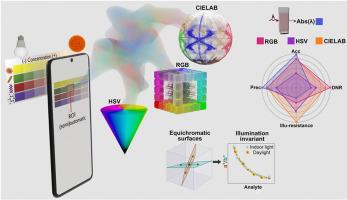最佳色彩空间使优势的智能手机为基础的比色感应。
IF 10.5
1区 生物学
Q1 BIOPHYSICS
引用次数: 0
摘要
基于智能手机的比色(生物)传感是一种很有前途的替代现场测试的传统检测设备,但它通常受限于对照明条件的敏感性。使用固定光源的外壳通常可以避免这些问题,增加现场测试的成本和复杂性,其中简单性,可移植性和可负担性是优先考虑的。在这项研究中,我们证明了仔细优化色彩空间可以显著提高基于智能手机的比色传感性能,实现无外壳、光照不变的检测。我们评估了基于智能手机的比色法的定量性能,该比色法使用覆盖广泛可见光谱的光谱成分的单色阴影。从感兴趣区域(ROI)中提取颜色坐标,使用自制的算法自动选择感兴趣区域。与基于吸光度的模型相比,基于智能手机的比色法提供了更宽的测量范围和相当的检测限。然而,基于RGB空间的模型对光照变化高度敏感,限制了其可靠性。相比之下,CIELAB颜色空间-特别是a *和b *色坐标-表现出对光照变化的固有抵抗。我们的等色表面概念解释了这种对闪电变化的固有弹性,为设计光照不变光学(生物)传感器提供了理论基础。本文章由计算机程序翻译,如有差异,请以英文原文为准。

The optimal color space enables advantageous smartphone-based colorimetric sensing
Smartphone-based colorimetric (bio)sensing is a promising alternative to conventional detection equipment for on-site testing, but it is often limited by sensitivity to lighting conditions. These issues are usually avoided using housings with fixed light sources, increasing the cost and complexity of the on-site test, where simplicity, portability, and affordability are a priority. In this study, we demonstrate that careful optimization of color space can significantly boost the performance of smartphone-based colorimetric sensing, enabling housing-free, illumination-invariant detection. We evaluated the quantification performance of smartphone-based colorimetry using monotonal shadings of colors with spectral compositions covering a wide range of visible spectra. The color coordinates were extracted from regions of interest (ROI) that were automatically selected using a homemade algorithm. Compared to absorbance-based models, smartphone-based colorimetry offered a broader measurement range with a comparable limit of detection. However, models based on RGB space proved highly sensitive to illumination changes, limiting their reliability. In contrast, the CIELAB color space—specifically the a∗ and b∗ chromatic coordinates—, exhibited inherent resistance to illumination changes. Our concept of equichromatic surfaces explains this inherent resilience to lightning variations, providing a theoretical basis for designing illumination-invariant optical (bio)sensors.
求助全文
通过发布文献求助,成功后即可免费获取论文全文。
去求助
来源期刊

Biosensors and Bioelectronics
工程技术-电化学
CiteScore
20.80
自引率
7.10%
发文量
1006
审稿时长
29 days
期刊介绍:
Biosensors & Bioelectronics, along with its open access companion journal Biosensors & Bioelectronics: X, is the leading international publication in the field of biosensors and bioelectronics. It covers research, design, development, and application of biosensors, which are analytical devices incorporating biological materials with physicochemical transducers. These devices, including sensors, DNA chips, electronic noses, and lab-on-a-chip, produce digital signals proportional to specific analytes. Examples include immunosensors and enzyme-based biosensors, applied in various fields such as medicine, environmental monitoring, and food industry. The journal also focuses on molecular and supramolecular structures for enhancing device performance.
 求助内容:
求助内容: 应助结果提醒方式:
应助结果提醒方式:


